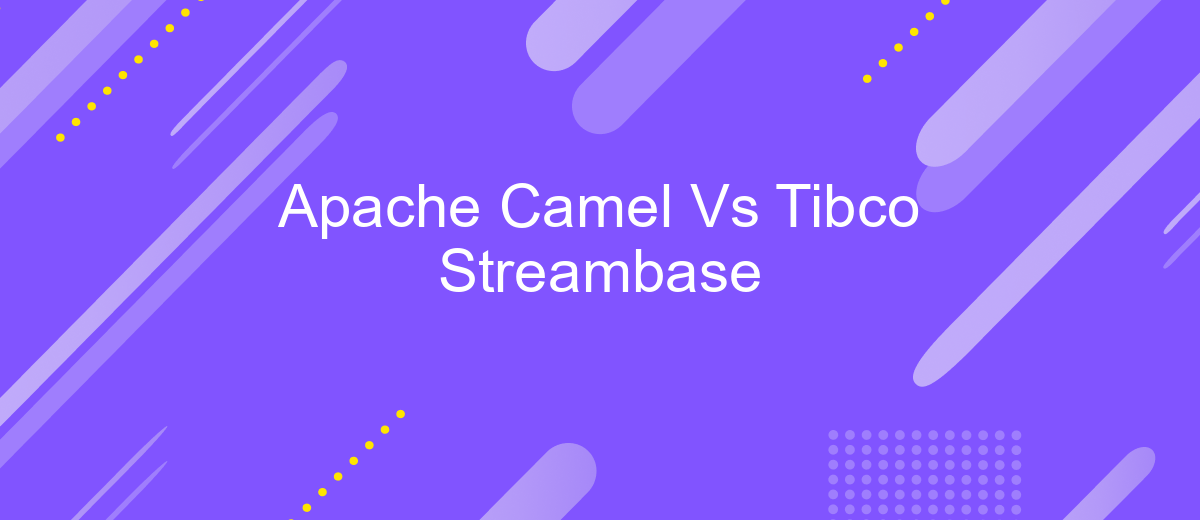Apache Camel Vs Tibco Streambase
When it comes to integrating complex systems and managing data streams, Apache Camel and Tibco StreamBase are two powerful tools that often come into consideration. Both offer unique features and capabilities tailored to specific needs. This article will delve into a comparative analysis of Apache Camel and Tibco StreamBase, helping you determine which solution best fits your integration and real-time data processing requirements.
Apache Camel Vs Tibco Streambase
Apache Camel and Tibco Streambase are both powerful tools for integration and real-time data processing, but they cater to different needs and use cases. Apache Camel is an open-source integration framework that provides a rule-based routing and mediation engine. It is known for its flexibility and the ability to integrate with various protocols and technologies.
- Apache Camel: Open-source, flexible, supports various protocols.
- Tibco Streambase: Real-time data processing, enterprise-grade, low-latency.
Tibco Streambase, on the other hand, is designed for real-time data analytics and complex event processing (CEP). It is an enterprise-grade solution that excels in low-latency environments. For businesses looking to simplify their integration processes, services like ApiX-Drive can be beneficial. ApiX-Drive offers an easy-to-use platform for connecting various applications and automating data flows without the need for extensive coding, making integration tasks more accessible and efficient.
Introduction

In the rapidly evolving landscape of enterprise integration, the need for robust and efficient tools is paramount. Apache Camel and Tibco Streambase represent two powerful solutions designed to streamline and enhance integration processes. Apache Camel, an open-source integration framework, offers a rule-based routing and mediation engine, making it a versatile choice for developers. On the other hand, Tibco Streambase, a commercial complex event processing (CEP) platform, excels in processing high-volume data streams in real-time, catering to industries that demand immediate insights and actions.
Choosing between Apache Camel and Tibco Streambase requires a thorough understanding of their capabilities and how they align with specific business needs. Apache Camel’s flexibility and extensive component library make it suitable for a wide range of integration scenarios. Tibco Streambase, with its focus on real-time data processing, is ideal for applications requiring instantaneous data analysis. Additionally, services like ApiX-Drive can further simplify integration processes by providing user-friendly interfaces and automation capabilities, allowing businesses to connect various applications seamlessly without extensive coding. Understanding these tools' strengths and limitations is crucial for making an informed decision that best supports your integration strategy.
Architecture

The architecture of Apache Camel and Tibco Streambase is fundamentally different, reflecting their distinct design philosophies and use cases. Apache Camel is a rule-based routing and mediation engine that provides a Java-based implementation of enterprise integration patterns (EIPs). It integrates with various data sources and endpoints through a wide range of connectors, making it highly flexible and adaptable for complex integration scenarios.
- Apache Camel uses a lightweight, modular architecture that allows developers to define routing and mediation rules in a variety of domain-specific languages (DSLs), including Java, XML, and Groovy.
- Tibco Streambase, on the other hand, is designed for real-time data processing and complex event processing (CEP). It uses a visual programming model where developers can create and manage data streams and event-driven applications through a graphical user interface.
- Both platforms can be enhanced with third-party services like ApiX-Drive, which simplifies the integration process by providing pre-built connectors and automation tools, thus reducing the development time and effort required for setting up integrations.
While Apache Camel excels in scenarios requiring extensive data transformation and routing logic, Tibco Streambase is ideal for applications needing real-time analytics and event processing. The choice between the two often depends on the specific requirements of the project, including the complexity of integration tasks and the need for real-time data handling.
Features

Apache Camel and Tibco Streambase are both powerful tools for integrating various systems and applications. Apache Camel is an open-source integration framework that provides a rule-based routing and mediation engine. It allows developers to integrate different applications using a wide array of predefined components and connectors.
Tibco Streambase, on the other hand, is a real-time event processing platform that allows for the rapid development and deployment of complex event-driven applications. It excels in scenarios where high throughput and low latency are critical, such as financial services and telecommunications.
- Apache Camel supports a wide variety of protocols and data formats.
- Tibco Streambase offers real-time analytics and complex event processing capabilities.
- Apache Camel integrates seamlessly with other Apache projects like ActiveMQ and Kafka.
- Tibco Streambase provides a visual development environment for easier application design.
- Both tools offer extensive documentation and community support.
For those looking to simplify the integration process further, services like ApiX-Drive can be incredibly useful. ApiX-Drive offers a user-friendly platform to automate data flows between different applications without writing any code. This can save time and reduce the complexity of managing integrations, making it a valuable addition to any integration strategy.
Use Cases
Apache Camel is ideal for organizations that require a flexible, open-source integration framework to connect various systems and applications. It excels in scenarios where developers need to implement Enterprise Integration Patterns (EIPs) and manage complex routing and mediation rules. For example, businesses can use Apache Camel to integrate different microservices, APIs, and legacy systems within their IT infrastructure, ensuring seamless data flow and process automation.
Tibco Streambase, on the other hand, is well-suited for real-time data processing and event-driven applications. It is particularly beneficial for industries that rely on rapid data analysis and decision-making, such as finance, telecommunications, and IoT. Tibco Streambase allows organizations to handle high-velocity data streams and execute complex event processing (CEP) with low latency. For instance, financial institutions can leverage Tibco Streambase to monitor and respond to market fluctuations in real-time, optimizing trading strategies and risk management. Both tools can be complemented with services like ApiX-Drive to streamline integration processes and enhance overall efficiency.
FAQ
What are the primary differences between Apache Camel and Tibco Streambase?
Which tool is better suited for real-time data processing?
Can Apache Camel and Tibco Streambase be used together?
What are the licensing differences between Apache Camel and Tibco Streambase?
How can I integrate Apache Camel or Tibco Streambase with other applications?
Apix-Drive is a universal tool that will quickly streamline any workflow, freeing you from routine and possible financial losses. Try ApiX-Drive in action and see how useful it is for you personally. In the meantime, when you are setting up connections between systems, think about where you are investing your free time, because now you will have much more of it.

